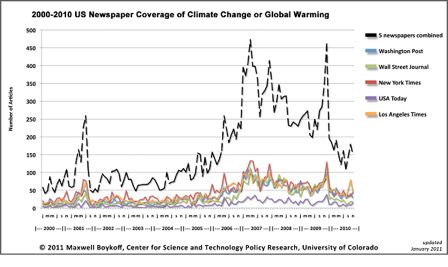This post originally appeared on the Yale Forum on Climate Change & the Media site and is graciously republished with permission.
Most Americans see or hear hundreds of advertisements every day. (The 3,000-ads-per-day figure you may have heard appears to be apocryphal; a 2007 Media Matters study estimates that each of us has “600 to 625 potential exposures” a day.) Whether it addresses the issue directly or ignores it entirely, each of these ads delivers a message, at least implicitly, about climate change. So just how have advertisers responded to the evolving public discussion of climate change in the U.S.?
To answer this question, The Yale Forum* conducted a study of advertisements in four national magazines from 2005 to 2010 (with an update through June 2011). The results indicate that advertising loosely tracked news media coverage and public opinion during this period, with “green” messages peaking, and including more keywords related to climate change, between the spring of 2008 and the fall of 2009. The data also suggest that after avoiding the issue for most of 2010, some companies are once again including nods to climate change in their pitches. The ad choices made by nuclear energy companies and associations during this period offer an interesting side story.
The Background: News and Public Opinion from 2005 to 2010
At the beginning of 2011, academic researchers Robert Brulle of Drexel University and Maxwell Boykoff of the University of Colorado both published graphs of media coverage of climate change through the end of 2010. Brulle’s research examined “nightly news coverage” by the three main news networks (ABC, CBS, NBC) from 1980 to 2010; Boykoff’s looked at the coverage by “prestige” newspapers from 2000 to 2010.
Brulle’s analysis of nightly news coverage of global warming from 1980 to 2010 on NBC, CBS, and ABC.
U.S. newspaper coverage of global warming. Credit: Max Boykoff, University of Colorado.
For the period 2005 to 2010, both graphs show rising trend lines from 2005 to the end of 2007, declining trend lines from 2008 through the middle of 2009, dramatic spikes in coverage at the end of 2009, and equally dramatic crashes in 2010. Brulle observed that coverage of climate change at the end of this period nearly matched the low levels at its beginning.
Gallup’s annual global warming poll, last conducted in March 2011, shows that public concern, too, has returned to 2005 levels. (In fact, the level of concern in 2011 is only marginally higher than the lowest figure, 50 percent in 1997, that Gallup has recorded since starting the poll in 1989. But instead of the twin peaks observed by Brulle and Boycoff, Gallup’s data for 2005 to 2010 plots out as a gentle hill, which reached its height roughly a year after the spring 2007 peak in news coverage.

The Study: Green Ads from 2005 to 2010
To determine how American and international companies responded to these changing levels of coverage and concern, The Yale Forum examined full-page ads placed in The Atlantic, National Geographic, National Review, and Time from January 2005 through June 2011.
Three of these magazines -- The Atlantic, National Geographic and Time -- were chosen because they are well-established -- founded in 1857, 1888, and 1923, respectively -- and well-produced mainstream publications that, with their different emphases and publishing cycles, attract a broad range of readers and advertisers. Anecdotal evidence suggests that the print ads placed in these magazines by major companies are part of larger campaigns that include national broadcast and cable networks. The print ads are, in other words, representative.
National Review, the conservative magazine founded in 1955 by William F. Buckley, Jr., was chosen as a possible counterpoint. Given National Review’s well-established editorial opposition to action on climate change, would advertisers avoid the issue altogether, or frame it in some special way?
The analysis consisted of counting the number of full-page ads in each issue and then determining the percentage of these ads that made an environmental claim or pitch. Each “green” ad was then examined more closely for key terms related to climate change. (A more detailed explanation of methodology is included in the sidebar to this story.)
Since the emergence of the environmental movement in the 1970s, many companies have sought to “green” their public images, likely resulting in a fairly steady background level of green ads. The actual results confirmed this expectation but confounded others.
Percent of Full-Page Ads in Each Issue, from 2005-2010, Classified as “Green”
For three of the four magazines analyzed, the plotted data reflect aspects of the news coverage and public opinion graphs. The main feature is a curve that tops out in 2008. However, there is also a smaller, and sharper, peak in the fourth quarter of 2009. Ads with green messages clearly became a bigger part of the ad mix as public concern about global warming increased. Their ratio of the total declined through the latter half of 2008 and the first half of 2009, but in contrast to Gallup’s public opinion data, green ads again increased their share of the total ad content of magazines, although only slightly, at the end of 2009. This increase in green ads is especially dramatic for National Review, which reflects the twin-peak pattern found in the Brulle and Boykoff graphs.
A very different trend line is traced by the quarterly tallies for “carbon dioxide,” “CO2,” “greenhouse gases,” and/or “greenhouse gas emissions.” In the graph below, the multi-colored bars depict, for each quarter and for all four magazines, the total number of ads that include one or more of these key words in their copy. These numbers clearly build to a peak in the fourth quarter of 2009 and then crash, decisively, in the first and second quarters of 2010.
Number of Full-Page Ads that include “Carbon Dioxide,” “CO2,” or “Greenhouse Gases” in their copy, from 1Q 2005 to 1Q 2011
The total number of ads mentioning “carbon dioxide” or “greenhouse gases” in the fourth quarter of 2009 is, however, just 26. This count constitutes only 42 percent of the “green” ads for that quarter, which in turn constitute just 21 percent of the total number of full-page ads. The large spike in ads directly mentioning “carbon dioxide” or “greenhouse gases” thus represents only 8.7 percent of the total. And of these 26 ads, only three mention “climate change” or “global warming” -- and two of these mentions occur in National Review.
From Numbers to Meanings: Interpreting the Results
At the beginning and end of the period studied, roughly 5 percent of the full-page ads in three of the four magazines carried “green” messages of some sort. This 5 percent likely represents the background level of environmental ads referred to earlier. Before climate change became a widespread concern among the public, companies “greened” their public images by touting their efficient use of natural resources and their careful disposal of wastes, while sometimes also noting that a small percentage of their proceeds would be donated for preserving nature. Because they are uncontroversial, these assertions are relatively safe environmental messages to embrace, although they may leave companies open to claims of “greenwashing.” The desire to avoid controversy may be the reason behind the clear preference for the more general “emissions” over “carbon dioxide” or “greenhouse gases” -- and the nearly universal avoidance of “climate change” and “global warming” -- even as public interest in the issue began to heat up. Better to address the new concern for climate change in the older, more familiar, and less controversial terms of conservation and pollution. Thus when early ads highlighted “reduced” or “lower emissions,” the public benefit was “cleaner air.” Even early BP ads that bucked this trend by referring to “low carbon diet” and “carbon footprint” did not mention “climate change.”
As Brulle’s annotations to his graph suggest, the theater release and popular and critical success of An Inconvenient Truth in 2006 appears to be one of the main drivers for the rise in news coverage of climate change in 2007 and the subsequent rise in public concern in 2008. The major multi-nationals, chiefly car and energy companies, seem to have waited for the public to respond before increasing their own expressions of concern. In other words, the companies responded to the polling rather than to news coverage. And as public concern increased, some ads became more explicit.
For instance, a Honda ad in the January 2008 issue of The Atlantic is one of the few to identify all the pieces of the puzzle, and in relatively large print: “Higher fuel efficiency, lower greenhouse gas emissions … which means our vehicles have emitted less CO2 -- the primary cause of global warming -- on average, than any other car company.”
A Siemens ad in the December 2008 issue of National Geographic boasts that using the company's equipment can eliminate “up to 40,000 tons of CO2.” But the ad points only to “cleaner energy”; climate change is not mentioned.
The most prominent reference to CO2 occurs in a two-page spread inside the front cover of the July 2009 issue of The Atlantic. The cartoonish Shell ad depicts a butterfly net about to capture a very large “CO2,” printed in a dark blue, bubbled font. But this playful introduction to Shell’s carbon capture and storage initiative never mentions climate change or global warming.

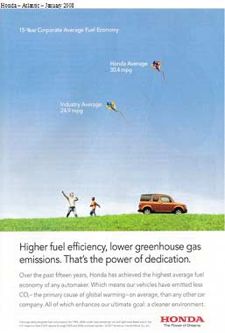

The July 2009 issue of The Atlantic shipped in early June. On June 26th, the House passed the Waxman-Markey cap-and-trade bill, the high-water mark for U.S. action on climate change. In the ads reviewed for this study, “CO2” never appeared in such big letters again. The 26 references to “CO2” or “greenhouse gases” in ads from the fourth quarter of 2009, in the weeks leading up to the major climate conference in Copenhagen in December, were consigned to the small print. And given that space for those ads was purchased weeks before the magazine issues were released, this final spike is likely the result of companies anticipating increased coverage of climate change driven by the Copenhagen conference.
By the January 2010 issue of The Atlantic, however, Shell had refocused its energies on “delivering heat to our cities” -- almost a repudiation of concern for global warming. Other energy companies emphasized job-creation and community building. Auto companies touted their engines’ power and fuel efficiencies. “CO2” disappeared almost entirely.
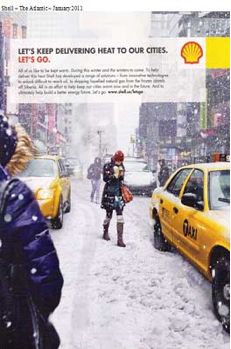
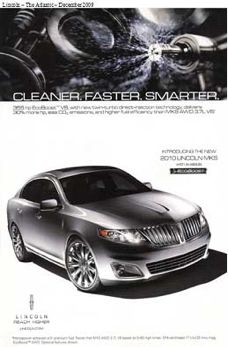
Why the change? By the end of 2009, the conference in Copenhagen had failed to deliver any meaningful action on climate change, the controversy over hacked e-mails had reached full boil, and the Northeast had experienced an attention-getting snowstorm. Again likely in anticipation of rather than in response to rising negative coverage, companies backed away from “climate change.”
With one notable exception.
The Special Case of Ads in National Review
A major surprise of the study was the stance taken by nuclear energy companies and trade associations in the pages of the conservative -- and climate change-skeptical -- National Review. Some of the most direct and emphatic references to global warming are in ads placed by Areva, a French nuclear energy consortium; Exelon, an American energy conglomerate that operates several nuclear power plants; and the Nuclear Energy Institute, a U.S. trade association for companies involved in nuclear energy. As these companies and associations are quick to point out, the generation of electricity through nuclear energy does not directly contribute to global warming.
An Exelon ad in the May 2008 issue of National Review, for example, gets straight to that point: “Global warming demands action. We’re not waiting.”
Even in February 2011, after the crash in news coverage and concern was apparent, Areva still seeks to write the story of energy “with less CO2.”

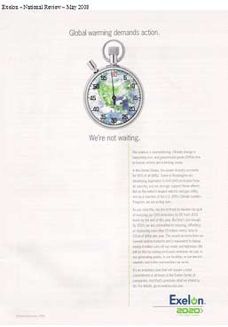
Why place such ads in National Review? Nuclear energy will look much more affordable if the cost of carbon is added to the prices of fossil fuels, but conservatives, although generally avid supporters of nuclear energy, are also primary opponents of legislative efforts to address climate change. These ads seem designed to offer conservatives a reason to get on board. And likely for this reason, the nuclear energy ads in the pages of National Review are “balanced” by ads purchased by coal companies and by “The People of the Oil and Natural Gas Industry.” Dueling energy ads were the status quo until the accident at Fukushima, after which ads for nuclear energy largely vanished. Now the only references to “climate change” and “greenhouse gases” are in the mock-ish stylings of National Review columnists. (Update: the June 6, 2011, issue of National Review included, inside the front cover, a Nuclear Energy Institute ad that explains “why nuclear energy is safe.”)
Reasons to Hope?
During World War II, American companies reinforced the national war effort by placing ads that depicted the power of their war machines, that highlighted their own efforts to conserve scarce resources, or that urged Americans to “Buy War Bonds” and to scavenge metals and other materials for manufacturing armaments. By complementing newspaper stories, radio broadcasts, and newsreels, these ads played an important supporting role in America’s original World-War-II-scale effort.
By the spring of 2010, one of the most vigorous efforts to mobilize American action on climate change had come to an end. Most companies now preen their public images by linking to other public concerns. But not all. Some companies have a vital stake in a low-carbon economy. For example, any company building and selling hybrids or electric vehicles, or the supporting infrastructure (think G.E.), may have at least some interest in re-building the momentum behind action on climate change. And some of these companies have begun to act; two of the four magazines included in this study showed a slight uptick in the percentage of green ads in the second quarter of 2011.

Perhaps because it is seen by some as already allied with the Obama administration as a result of the bailout, or perhaps because it sees an opportunity to claim a larger share of the hybrid market while its Japanese competitors are hobbled by strained supply lines, General Motors’ Chevrolet division has launched -- in magazines, on television, on the web -- one of the “green”-est advertising campaigns in years. When you buy a new Chevy, the company promises on the campaign website, “we will invest in renewable energy, energy efficiency programs, and planting trees across America.” By linking together efficiency, energy alternatives, and the carbon cycle, the “Chevy Runs Deep” ads might contribute to the next effort to mobilize action. But whether they can do so without first mustering the courage to say “climate change” remains to be seen.
Addendum:
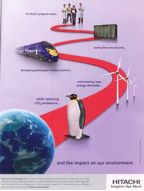
As a result of the delay caused by the redesign of The Yale Forum website, the author has had the opportunity to review the July/August 2011 issue of The Atlantic and the July 2011 issue of National Geographic. In both issues the percentage of green ads increased: to 13 percent in The Atlantic, to 19 percent in National Geographic. More surprising were the three explicit mentions of “C02,” in the big print in the case of the ad Hitachi purchased in The Atlantic. If the other magazines followed suit, through the end of September, the final tally for 3Q 2011 would match that for the 3Q 2009. The closest these ads get to “climate change,” however, is the reference to “climate emissions” in Shell’s wordy notice for its 2010 Sustainability Report, which was one of four full-page advertisements it purchased in the July/August issue of The Atlantic. (The third of these ads, inside the back cover, is the “Let’s keep delivering heat to our cities” ad mentioned earlier in this post. In July? What was Shell thinking?)
Research Methods
This study used definitions provided by Julia Corbett in “Four Types of Ads Featuring the Environment,” a chapter in her 2006 book, Communicating Nature: How We Create and Understand Environmental Messages. Because the purpose of this study was to measure engagement with environmental issues, “nature as backdrop” ads were not tallied. To be counted as “green,” an ad had to make a “green” claim about a company’s product or service, or tout the company’s own “green” actions, or advocate action on a “green” cause or concern.
To meet the study’s two goals -- tracking changes in the ratio of green ads over the last six years as well as following the changing messages of specific advertisers -- the following tasks were completed for each issue of the four publications analyzed. (Note: Full-runs (i.e., every issue) of the two monthlies, The Atlantic and National Geographic, were analyzed; representative samples (i.e., 12 issues per year) were analyzed for the bi-weekly National Review and for the newsweekly, Time.)
- In order to factor out dramatic seasonal variations in advertising, the quantity of green ads is expressed as a percentage of the total number of full-page ads; the first step, then, was to count the number of full-page ads in the issue.
- The substantive “green” ads -- “green product attribute,” “green image,” or “environmental advocacy” ads -- were then identified and tallied.
- To determine the degree to which a company engaged the more specific issue of climate change, each green ad was carefully examined for three different sets of keywords regarding energy alternatives, greenhouse gases, and “climate change” or “global warming.”
- These quantitative results -- for percentages of green ads and mentions of keywords -- were then tallied and graphed by quarter (e.g., 2005 - 1Q, 2005 - 2Q, etc.).
- To track the changing responses of individual companies, ads were collected across the time period. In other words, if a company like Chevron published a run of green ads in 2008, Chevron ads from 2005, 2006, 2007, 2009, and 2010 were collected in order to determine how their messaging changed over this period.
***
*Michael Svoboda wishes to thank his fall 2010 students -- Philip Alvarez-Correa, Wynn Bakirtjy, Arthur Bianchi, Catherine Blauch, Stephen Budhi, Maxwell Cohen, Amanda Davanzo, Jason Gamache, Ashley Hughes, Kenneth Hurt, Nigel Isom, Anthony Korzan, Pierce Lewis-Oakes, Alexander Moran, Jordan Muchnik, Andrea Oropeza Clark, Alexander Moran, Stephen Pasinski, Christopher Ring, Macaulan Servan-Chiaramonte, Emilie Solomon, Scott Traum, Will Tucker, Javier Uribe, Chelsey Weatherford, Yoo Young Yoon -- for their help in conducting a test analysis of green ads in The Atlantic.
Michael Svoboda is an Asst. Prof. of Writing at The George Washington University. Previously the owner of an academic bookstore, he now tracks and analyzes efforts to communicate climate change, including the stream of research and policy published by NGOs. E-mail: [email protected]. He also wrote an article about the five-year period following the release of An Inconvenient Truth.

_442_259_80.jpg)
